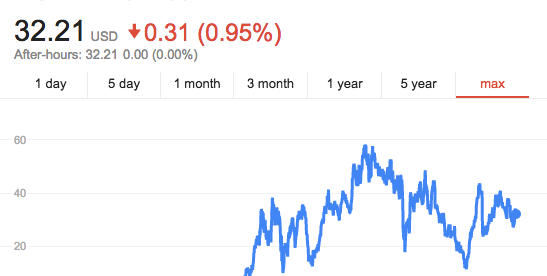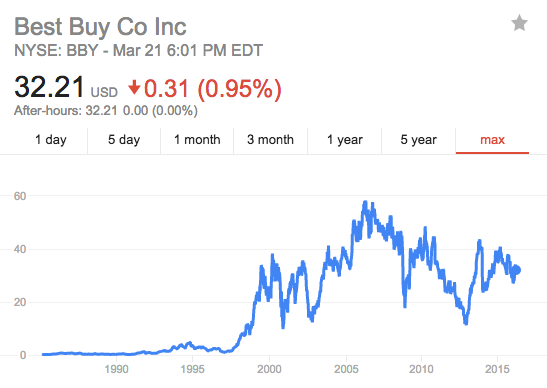Second-Best Buy


The consumer electronics megastore Best Buy was founded in the 1960s in Minnesota as a stereo store called “Sound of Music,” and by 1987 emerged on the New York Stock Exchange as something similar to its current incarnation. As of 2014, it was the 11th largest retailer in the U.S. (by retail sales, in dollars), but for a while, it wasn’t looking too good. From 2006 through 2012, Best Buy — as the graph above notes — didn’t do too well. The main culprit, to no one’s surprise, was the widespread adoption of online shopping.
Perhaps worse than most other retailers, Best Buy fell prey to what the industry called “showrooming.” Consumers would go online and check the price of an item on Amazon, on Walmart’s website, etc., and note which option was the cheapest. But many of these consumers would pause before hitting the “buy” button. When it came to electronics in particular, would-be purchasers often had questions about the product or wanted to hold or examine the item before purchasing. Doing that online proved impossible, but no worries — that could be fixed by a short drive to the nearest Best Buy. The somewhat-knowledgable employees may know the answers to those questions, and in any event, you could play around with a device a bit before purchasing. But, because the price was often cheaper online, Best Buy’s sales weren’t reflective of this customer experience. Instead of buying the item on the spot, the price-sensitive shopper would go home and buy it from an online retailer — leaving Best Buy as an uncompensated electronics concierge.
In recent years, Best Buy has combatted the “showrooming” effect by instituting a price matching scheme — if you see the same item online for less, they’ll often sell you the item for that price. But in 2007, the company was apparently engaged in a different way to combat online shoppers — Best Buy set up a fake, in-store version of their own website.
The imbroglio began in January of 2007 when a reporter for the Hartford Courant decided to verify a reader tip. The reader had claimed that Best Buy, on its own website, was selling a computer for $729, marked down $150. But when the reader went to the store, the employees informed him that the sale was over, and that the computer was now only available at the full retail price of $879. And the customer need not take the employee’s word for it, either. The store had kiosks which, apparently, would allow customers to access Best Buy’s website from the salesroom floor. The customer did just that, and the price on the screen — on something which purported to be Best Buy’s website and looked just like it — was at $879.
Amazed that the price could change so quickly, the customer — still at the store — asked to use the open a web browser on one of these in-store kiosks. He was allowed to do so and went to Best Buy’s website by typing in the URL instead of using the store’s pre-made icon. He found that the price was listed as $729. The store sold him the computer at the discounted price, but the customer told the local news anyway. And a few days later, the reporter was able to replicate the same thing. At home, the website showed one price. In the store, the website showed a different, typically higher price.
The Attorney General of Connecticut investigated the issue and Best Buy quickly cratered. In a follow-up piece, the Courant reported that the company acknowledged the existence of the second website and agreed to cooperate with Connecticut’s officials — but denied that this second website was intended to deceive. Instead, they added a disclaimer, as the Los Angeles Times reported in December of that year:
To access the in-store site, I had to click on a link marked “Bestbuy.com,” which would seem to indicate pretty plainly that I was going to the company’s website.
The in-store site was virtually indistinguishable from the actual website. Across the top were the same tabs linking to various product categories. There was also the same banner offering details for holiday deliveries.
The only significant difference was an inch-wide yellow strip sandwiched between the tabs and delivery notice that said, “This kiosk displays in-store prices — which may differ from national Internet prices. Promotions can differ between stores and Internet. See your sales associate if you have questions.”
To its credit, Best Buy informed its staff, nationwide, that if a customer noticed the price discrepancy and asked for a discount, the store should sell the item at the lower of the two prices. That probably happened very rarely, though. In December of 2010 — four years after the Courant broke the story — Best Buy settled with the State of Connecticut. Per the Consumerist, the retailer agreed to pay $399,000 to the state, and to reimburse any Connecticut customers who demonstrated that they were negatively affected by the second-website snafu. In total, only sixteen people in the state were compensated through that part of the settlement.
Bonus Fact: A real store with a fake website is strange, but what about a fake university with a real website? Monsters University isn’t a real place — it’s the fictional college from the 2013 movie of the same name — but you can visit it online. The robust website features an abridged student handbook, information on Greek life, highlighted faculty, and a detailed campus map (pdf). Unfortunately, applications for the next term are not currently being accepted.
From the Archives: Free For Me But Not For Thee: The story of an absurdly expensive website.
Take the Quiz: Let’s go back in time a few years. Name the largest U.S. retailers in 2008.
Related: Monster University. On Amazon, not Best Buy.
